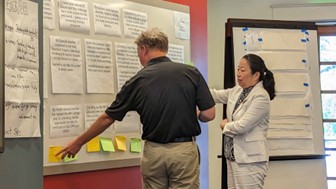
(Repost of an April 2024, post on the REL Appalachia Blog. REL AP serves educators in Kentucky, Tennessee, Virginia, and West Virginia to support use of data and evidence to improve academic outcomes for students.)
April 30, 2024 | By Stephanie Suarez
Responding to alarm
In recent years, Tennessee education leaders have expressed concern over stagnant or declining college enrollment rates and a weak education-to-workforce pipeline.1 According to the State Collaborative on Reforming Education, only 26 percent of Tennessee students who started high school in 2012 earned a postsecondary degree by summer 2022, with even lower percentages for students of color over the same time period.1,2 Alarms were sounding.
In response, the Niswonger Foundation convened education leaders from nine districts in northeastern Tennessee to collaborate with REL Appalachia in the Strengthening Students’ Preparation for College and Careers (SSPCC) partnership. This blog post outlines how this partnership sought to strengthen students’ college and career readiness efforts by building district capacity to innovate and embed evidence-based practices.
Consulting the research
First, to understand how to support students’ postsecondary transitions through a holistic approach, REL Appalachia staff looked at the research. We considered research on not only academics, but also other dimensions that impact postsecondary readiness.
We found that, together, the four dimensions of preparation below form the supports necessary to lead to postsecondary success, whether in college, careers, or military service.
 Academic Academic |
 Social-emotional Social-emotional |
 Financial Financial |
 Logistical Logistical |

To emphasize that these four supports work holistically and not independently, we represented them as pillars of a bridge from high school to students’ futures in the “Four Pillars of Support for High School Students’ College and Career Readiness” infographic.
We also gathered evidence-based strategies aligned to each of these pillars and included them in the infographic to share with SSPCC partners.
Looking at different types of data, including student voice
SSPCC partners then analyzed their district-level college and career readiness data in relation to the four pillars of support to identify areas for improvement. When the partners looked at college enrollment rates, for example, they noticed disparities in these rates across student groups.
These disparities prompted the partners to ask questions. For example, “How do postsecondary outcomes such as college attendance and employment vary by school and student characteristics?” To answer this question, they looked at quantitative data such as college enrollment rates and career and technical education (CTE) credential attainment rates.
The partners also looked at qualitative data to better understand why variations might exist. The Tennessee educators in the SSPCC partnership asked their students two powerful questions:
“Tell me about a great experience you had at school where you got the help you needed for college and career preparation.”
“Tell me about a bad experience you had at school where you didn’t get the help you needed for college and career preparation.”
The partners then reviewed students’ feedback to identify common themes:


Overall, SSPCC partners realized that the responses were all connected to the four pillars of support for college and career readiness (academic, logistical, financial, and social-emotional).
Realizing the need for systemic change

When they heard these student voices, the partners were transported to their own experiences with preparing for college and careers, years earlier. REL Appalachia staff wanted to harness this power of stories and lived experience to motivate change. So, we asked the partners to reflect further on their experiences.
When partners compared the students’ responses with their own lived experiences, there was a lightning bolt moment of realization. The partners realized that many students today face the same challenges they did, decades earlier, such as not receiving enough guidance on navigating the college application process or finding and applying for scholarships.3
Because similar challenges have persisted, SSPCC partners understood that systemic changes were needed. This exercise built collective ownership for college and career preparation—that all adults in the education system play an important role in preparing students for college and careers.
Considering evidence-based practices to inform improvements
After consulting the research, looking at the data, listening to students, reflecting on their own experiences, and noticing persistent challenges, SSPCC partners are now utilizing evidence-based strategies outlined in the “Four Pillars of Support for High School Students’ College and Career Readiness” infographic to identify improvements they can make in their systems to better support students’ preparation for college and careers.
Example evidence-based practices related to the four pillars of support include:

Academic preparation: Education leaders can partner with counselors or university admission representatives to create opportunities such as assemblies or classroom workshops to ensure all grade 9 students receive information about academic requirements for college enrollment.

Social-emotional preparation: CTE leaders can partner with core-subject instructors to help increase students’ awareness about local internships and externships to support career exploration.

Financial preparation: Educators and education leaders can increase outreach for financial aid or college scholarship nights to ensure all students receive the information.

Logistical preparation: English teachers can integrate college admission essay requirements into their coursework to help all students prepare for college admission requirements.
Educators seeking to strengthen students’ preparation for college and careers through a holistic approach can harness the bridge framework and evidence-based strategies above, as well as more strategies provided in REL Appalachia’s “Four Pillars of Support for High School Students’ College and Career Readiness” infographic.
Resources to learn more
Learn about our partnership: Visit our Strengthening Students’ Preparation for College and Careers partnership page to learn more about how REL Appalachia is supporting educators in northeastern Tennessee.
Explore and consider replicating: Check out materials from a recent conference session where REL Appalachia staff shared the work of this partnership. Educators can review the student scenarios in the materials and discuss with their teams how they would support their own students with a similar situation. This activity could be a starting point to brainstorm ideas for improving student supports.
Self-assess: Take this brief self-assessment to understand how well your school, district, or organization is preparing students for college and careers, by each pillar of support.
Stay connected: Subscribe to the REL Appalachia quarterly newsletter to receive updates on new products and projects as we support students in Kentucky, Tennessee, Virginia, and West Virginia.
References
1 Frist, B. & Mansouri, D. (2024, January 23). Tennessee’s higher education must better meet student needs and workforce demands. The Tennessean. https://www.tennessean.com/story/opinion/contributors/2024/01/23/higher-education-tennessee-score-workforce-pipeline-outcomes-data/72312008007/
2 Walker, K. (2022, December 8). Fewer Tennesseans going to college, study shows, News Channel 9. https://newschannel9.com/newsletter-daily/less-tennesseans-going-to-college-study-shows-
3 Belton, N. (2023, November 9). Data-driven decision-making in education: How REL work makes a difference. NCEE Blog. https://ies.ed.gov/blogs/ncee/post/data-driven-decision-making-in-education-how-rel-work-makes-a-difference
Published June 2024.
